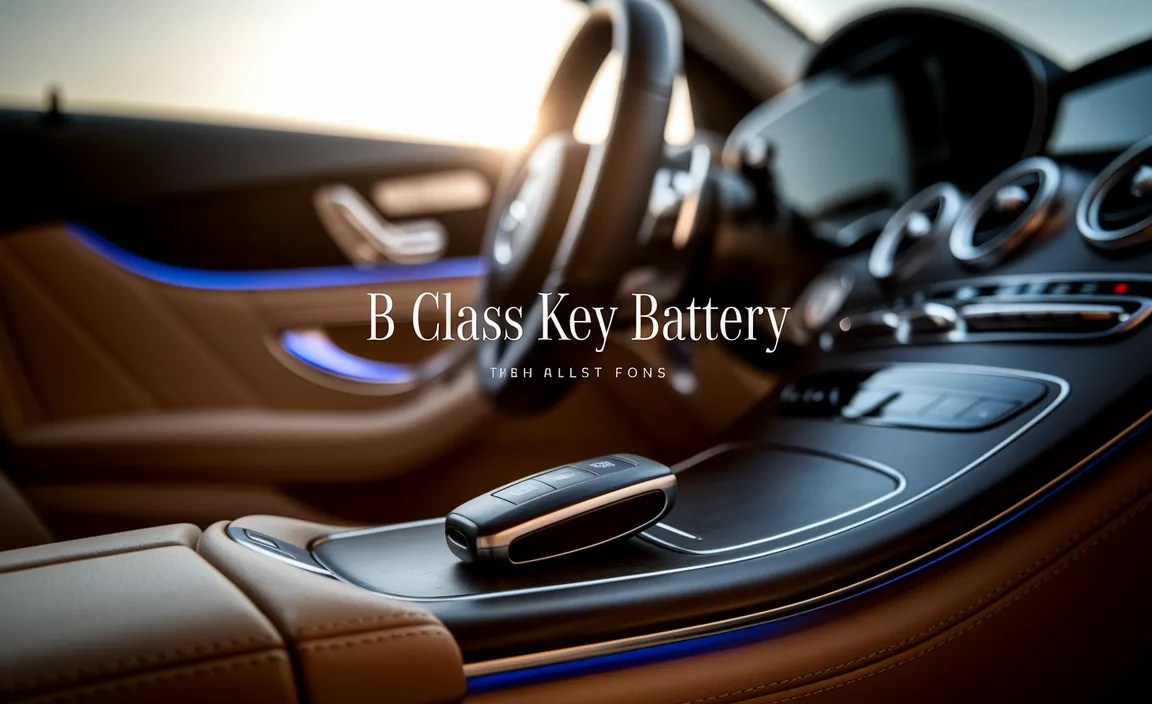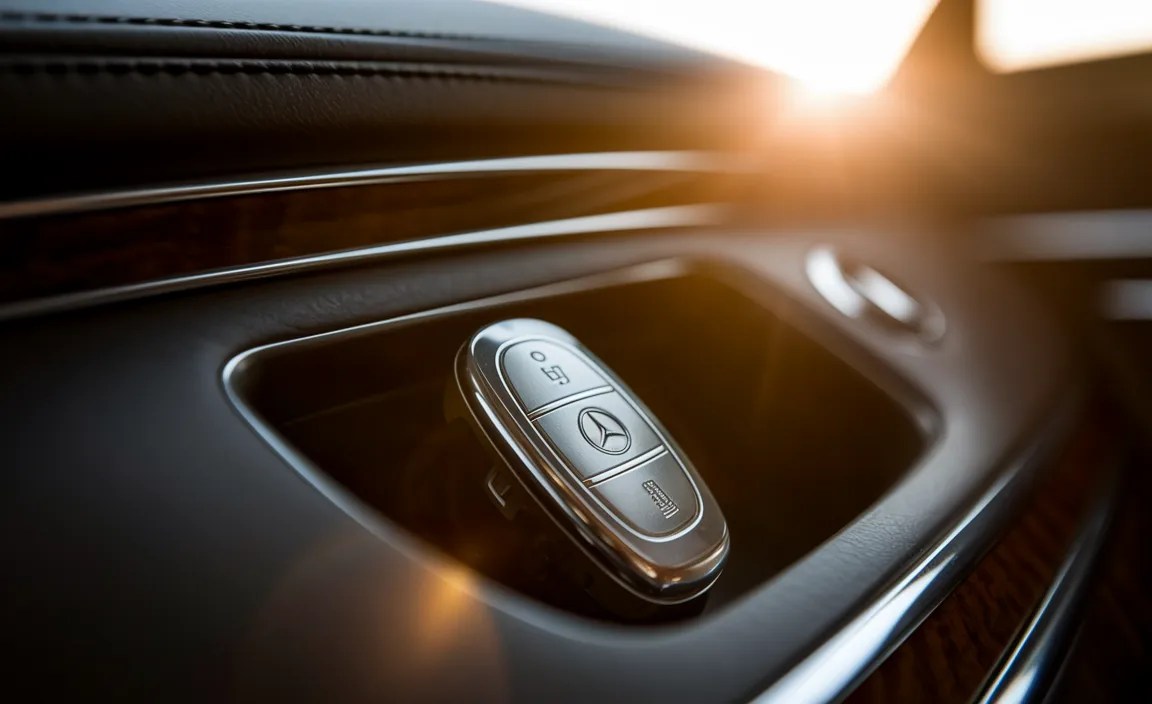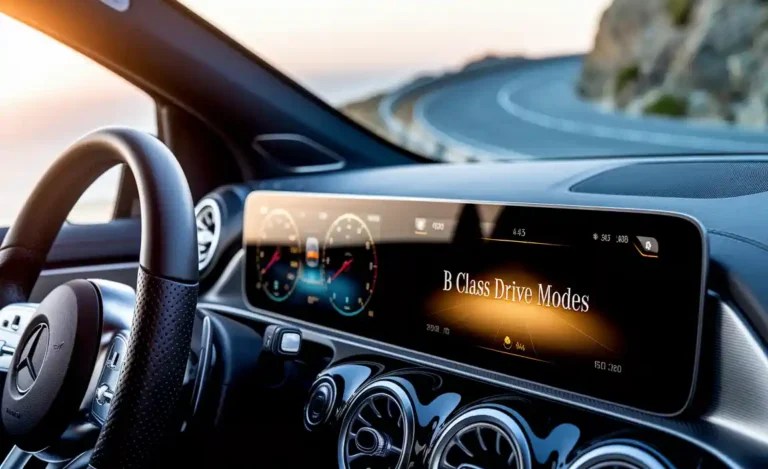B Class Key Battery: The Essential Upgrade
The B-Class key battery is crucial for your car’s convenience and security. Replacing it is a simple yet essential upgrade that prevents lockout and ensures all remote functions work. This guide makes it easy to understand and execute.

Ever been caught by a dead key fob just when you’re in a hurry? It’s a frustrating moment every driver experiences. For Mercedes-Benz B-Class owners, this inconvenience can extend to locking doors, starting the engine, or using the trunk release. The culprit is often a simple, depleted battery within your sophisticated key fob. Don’t let a low battery dictate your day or leave you stranded.
At MercedesBlue, we believe in empowering you with the knowledge to keep your prized vehicle running smoothly and conveniently. This guide will demystify the B-Class key battery, explain why an upgrade is so important, and walk you through the straightforward process of replacing it yourself. We’ll cover everything you need to know, ensuring you can confidently perform this essential maintenance. Get ready to restore full functionality to your Mercedes-Benz B-Class key fob!
Understanding Your B-Class Key Fob Battery
Your Mercedes-Benz B-Class key fob is a marvel of modern engineering, packed with technology that offers seamless access and control over your vehicle. At its core, this technology relies on a small, yet vital, power source: the key fob battery. Without sufficient power, the fob’s signals can become weak or cease altogether, preventing it from communicating with your car.

These batteries are typically coin-cell or button-cell types, readily available and designed for long life. However, like all batteries, they have a finite lifespan. Factors such as usage frequency, age, and even extreme temperatures can influence how long your key fob battery lasts. Mercedes-Benz vehicles, with their advanced security and convenience features, are particularly sensitive to low battery power in the key fob, making timely replacement a necessity.
Why Replace Your B-Class Key Battery?
Replacing your B-Class key battery isn’t merely about addressing a minor annoyance; it’s about ensuring the continued functionality and security of your vehicle. Here’s why it’s an essential upgrade:
- Uninterrupted Convenience: The most obvious benefit is maintaining the convenience of keyless entry, remote start, and trunk opening. Imagine never being locked out of your car because of a dead fob.
- Enhanced Security: Your key fob communicates securely with your B-Class. A weak battery can sometimes interfere with the car’s ability to recognize the fob, potentially causing security alerts or preventing ignition.
- Preventing Lockouts: A sudden dead battery can leave you stranded. Proactively replacing it, especially if you notice slower response times or dim indicator lights on the fob, can prevent a stressful lockout situation.
- Cost-Effectiveness: Replacing a key fob battery yourself is significantly cheaper than a dealership service call or a new key fob. It’s a simple DIY task that saves money.
- Preserving Fob Lifespan: Consistently draining the battery can, over time, potentially stress the fob’s internal components. Regular replacement ensures optimal operating conditions.
Identifying a Dying B-Class Key Battery
Your Mercedes-Benz B-Class is designed to give you cues when something isn’t quite right, and this includes the key fob’s battery level. Paying attention to these signs can save you from a potential inconvenience.
The most common indicator is a reduced range for your remote functions. You might find yourself needing to be much closer to the car than usual for the doors to unlock or lock. Another sign is a slower response time from the fob; you press the button, and it takes a noticeable moment for the car to react, or sometimes you have to press it multiple times.
| Symptom | Description | Action |
|---|---|---|
| Reduced Range | The distance at which your key fob can communicate with the car decreases significantly. | Prepare to replace the battery soon. |
| Slow Response Time | Pressing key fob buttons results in a delayed reaction from the vehicle, or requires multiple presses. | Replace the battery promptly. |
| Intermittent Functionality | Some functions might work sporadically, while others fail to respond. | This is a strong indicator that the battery is critically low. |
| Dashboard Warning | Some B-Class models may display a specific warning message on the dashboard indicating a low key fob battery. | Replace the battery immediately. |
| Vehicle Beeps/Hazards | In some cases, if the car detects a very weak signal or no signal from the fob, it might issue a warning beep or flash hazard lights. | This is a critical low battery situation. |
If you’re experiencing any of these symptoms, it’s a clear signal that your B-Class key battery is nearing retirement. It’s wise to replace it proactively, rather than waiting for it to die completely.
What You’ll Need: The Essential Tools
Fortunately, replacing your B-Class key battery is a straightforward process that requires minimal tools. You likely have most of what you need already, or they are readily available and inexpensive. This makes it an accessible DIY task for any owner.
- Replacement Battery: This is the most critical item. For most Mercedes-Benz B-Class models, the common battery type is a CR2032 3-volt lithium coin cell. Always confirm the exact battery type for your specific model year. You can often find this information in your owner’s manual.
- Small Flathead Screwdriver or Plastic Pry Tool: This is for gently prying open the key fob shell. A plastic pry tool is ideal as it minimizes the risk of scratching or damaging the fob. If using a flathead screwdriver, be extra careful. A small, thin one is best.
- Clean Cloth or Paper Towel: To handle the new battery. Fingerprints can leave oils that can degrade the battery’s contact and performance over time.
- Your B-Class Key Fob: Of course!
Before you begin, it’s a good idea to familiarize yourself with your specific key fob design. While most B-Class fobs share a similar mechanism, minor variations exist between model years. A quick look at some online videos showcasing your specific B-Class key fob model can be very helpful.
Step-by-Step: Replacing Your B-Class Key Battery
Now, let’s get to the practical part. Replacing the battery in your Mercedes-Benz B-Class key fob is typically a quick and simple procedure. Follow these steps carefully to ensure a smooth replacement.

Step 1: Accessing the Key Fob’s Internal Battery Compartment
Most Mercedes-Benz B-Class key fobs have a small cover that needs to be removed to access the battery. This is usually located on the side or the back of the fob.
- Locate the Seam: Examine your key fob. You’ll see a seam running around its perimeter where the two halves of the plastic casing meet.
- Find the Release Notch (if applicable): Some fobs have a small notch or slot along this seam. This is where you’ll insert your prying tool.
- Insert Pry Tool: Carefully insert the tip of your small flathead screwdriver or plastic pry tool into the notch.
- Gently Pry: Apply gentle, steady pressure to twist the tool or pry the two halves of the casing apart. You should hear a click as the clips holding it together release. Work your way around the seam if necessary, but avoid forcing it, as this can break the plastic. Some fobs might require you to slide a panel off instead of prying.
If your key fob has a removable emergency key blade, you might need to remove that first. Often, there’s a small button or latch to release it. consult your owner’s manual if you’re unsure. For example, on many Mercedes fobs, you press a small release button to slide the metal key out.
Step 2: Removing the Old Battery
Once the key fob casing is open, you’ll see the battery. It’s usually held in place by a small clip or fits snugly into a designated slot.
- Identify the Battery: Locate the coin-cell battery. It will be marked with its type, usually “CR2032.”
- Note the Polarity: Pay close attention to which side of the battery is facing up (the positive (+) side is typically marked and facing upwards). This is crucial for installing the new battery correctly.
- Remove the Battery: Gently use your pry tool or a fingertip to lift the old battery out of its compartment. It might pop out easily or require a little leverage.
Be careful not to touch the battery contacts inside the fob with your bare hands if possible. Residue can affect conductivity.
Step 3: Installing the New Battery
This is where you fit the fresh power source into your key fob.
- Handle with Care: Take the new CR2032 battery and hold it by its edges. Avoid touching the flat surfaces.
- Insert with Correct Polarity: Place the new battery into the compartment with the correct side facing up. Refer to the notes you made in Step 2 or the markings within the fob. The positive (+) side usually faces upwards.
- Secure the Battery: Ensure the battery is seated correctly and securely. It should fit snugly, and any retaining clips should snap back into place.
If the fob has a small plastic cover for the battery compartment, reattach it now.
Step 4: Reassembling the Key Fob
With the new battery in place, it’s time to put your key fob back together.
- Align the Casing Halves: Carefully align the two halves of the key fob casing.
- Snap Together: Press the halves firmly together. You should hear them snap shut, indicating that the internal clips have engaged. Work your way around the edge to ensure a secure fit.
- Reinsert Emergency Key (if applicable): If you removed the emergency key blade, slide it back into its slot until it locks into place.
Step 5: Testing Your Key Fob
The moment of truth! Test all the functions to confirm the new battery is working correctly.
- Test Remote Functions: Stand at a normal distance from your B-Class and test the lock, unlock, and trunk release buttons. They should now respond immediately and reliably.
- Test Ignition: Place the key fob in the ignition (if applicable to your model, some newer fobs don’t slot in) or in the designated area for starting the car. The car should start without any issues.
- Check Dashboard Indicators: Ensure no “low key battery” warnings persist on your dashboard.
If everything works as expected, congratulations! You’ve successfully replaced your B-Class key battery. It’s a simple yet rewarding task.
Battery Lifespan and Maintenance Tips
The lifespan of your B-Class key fob battery can vary, but with a little care and attention, you can maximize its longevity. Understanding what affects battery life and adopting smart habits can prevent premature failures.

Generally, a CR2032 battery can last anywhere from 1 to 3 years, depending on usage. If you use your remote start frequently, lock/unlock the car multiple times a day, or live in an area with extreme temperatures (very hot or very cold), this might shorten the battery’s life.
Tips for Extending Battery Life:
- Avoid Unnecessary Button Presses: Every press sends a signal and uses a bit of power. Try to press buttons only when you intend to perform an action.
- Keep Fobs Away from Magnets: Strong magnetic fields can interfere with electronic components and potentially drain batteries faster.
- Protect from Extreme Temperatures: Leaving your key fob in a hot car for extended periods or in freezing conditions can degrade the battery’s performance and lifespan.
- Store Safely: If you have multiple fobs, rotate their use. If one fob is rarely used, the battery inside might become depleted over time due to its own self-discharge rate.
- Consider a Replacement Fob Cover: Some aftermarket covers are designed to be more robust and offer better protection against accidental button presses when the fob is in a pocket or bag.
When you do replace the battery, always opt for reputable brands. While cheaper batteries might seem appealing, they may not offer the same longevity or reliability as quality replacements. For more information on battery specifications and general automotive electrical systems, resources like the U.S. Department of Energy’s guide on batteries offer excellent background information.
Troubleshooting Common Issues
Even with a new battery, you might occasionally run into a hiccup. Here are some common issues and how to address them:
Key Fob Still Not Working After Battery Replacement:
- Incorrect Battery Polarity: Double-check that the new battery is installed with the correct side facing up (+/-). This is the most common installation error.
- Faulty New Battery: While rare, new batteries can be defective. Try a different brand-new battery to rule this out.
- Corroded Contacts: Inspect the metal contacts inside the key fob. If they appear dirty or corroded, gently clean them with a pencil eraser or a cotton swab dipped in isopropyl alcohol. Let it dry completely before reassembling.
- Damaged Key Fob: The internal circuitry of the fob might be damaged from a drop or other impact. If all else fails, the fob itself may need repair or replacement.
Vehicle Not Recognizing Key Fob:
- Interference: Strong radio signals or other electronic devices nearby can sometimes interfere with the key fob’s signal. Try moving to a different location away from potential sources of interference.
- Key Fob Reprogramming: In rare cases, the key fob might lose its programming with the vehicle. This usually requires a trip to a Mercedes-Benz dealership or an independent specialist equipped with the necessary diagnostic tools to re-sync the fob.
If you suspect your key fob is damaged or requires reprogramming, it’s always best to consult a professional. While DIY is great for battery replacement, complex electrical issues may need expert attention.
Key Battery Types for Mercedes-Benz B-Class
As mentioned, the most common battery type for the Mercedes-Benz B-Class key fob is the CR2032. However, it’s always wise to confirm for your specific model year. Different generations or trim levels might occasionally use a slightly different battery.
Here’s a look at common coin cell battery types in automotive key fobs:
| Battery Type | Voltage | Common Uses | Appearance |
|---|---|---|---|
| CR2032 | 3V | Most Mercedes-Benz key fobs (including many B-Class models), car remotes, small electronics. | Silver, 30mm diameter, 3.2mm thick. Clearly marked “CR2032”. |
| CR2025 | 3V | Some car remotes, key fobs, calculators, medical devices. | Silver, 20mm diameter, 2.5mm thick. |
| CR2016 | 3V | Smaller devices, key fobs, fitness trackers, computer motherboards. | Silver, 20mm diameter, 1.6mm thick. |
| CR1632 | 3V | Key fobs, small electronic devices. | Silver, 16mm diameter, 3.2mm thick. |
The “CR” stands for lithium metal battery with a coin cell shape. The numbers following indicate the dimensions: the first two are the diameter in millimeters, and the last two are the thickness in millimeters. So, a CR2032 is 20mm in diameter and 3.2mm thick.
Where to find the correct battery:
- Your Owner’s Manual: This is the most definitive source for battery specification.
- Behind the Battery Cover: Often, the battery type is printed directly on the battery itself, visible once you open the fob.
- Online Mercedes-Benz Forums: Enthusiast communities are a wealth of shared knowledge.






